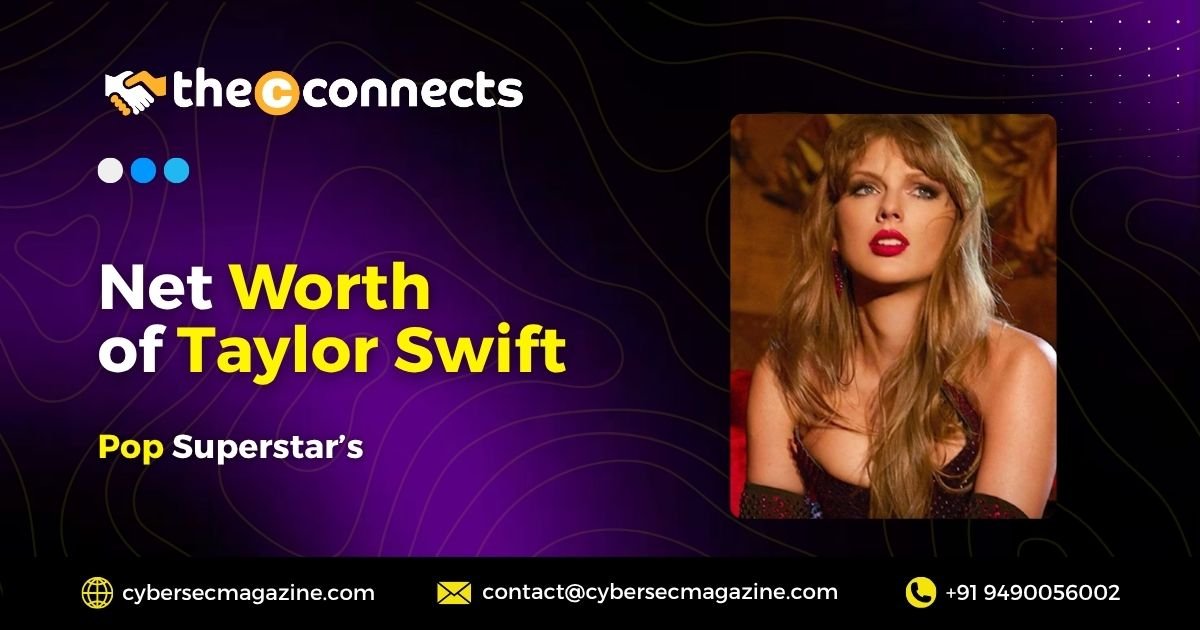By TheCconnects Magazine – for entrepreneurs, business leaders and C‑Suite professionals
In the realm of global pop culture, few names carry as much weight as Taylor Swift. But beyond the Grammys, stadium tours and fan phenomena, Swift has also established herself as a formidable business force-one whose financial trajectory offers key lessons in intellectual‑property value, brand mastery and strategic monetisation. For the readers of TheCconnects-top‑level executives, entrepreneurs and decision‑makers-her net worth isn’t just a celebrity headline; it’s a case study in how cultural influence, strategic rights ownership and high‑end execution translate into serious enterprise value.

Current Net Worth Estimate
As of 2025, credible sources estimate Taylor Swift’s net worth in the range of US $1.6 billion, with some reports identifying potential upside to US $2.1 billion.
- Forbes places her at around US$1.6 billion as of August 2025.
- Bloomberg and others suggest that with recent album and tour successes, her fortune may have climbed to US$2.1 billion in October 2025.
- Earlier estimates were lower: for example, prior to the major tour and catalogue moves, she was assessed at around US$1.4–1.5 billion.
For strategic business readers, this places Swift not simply in elite celebrity wealth territory but as a billionaire‑level creative enterprise-built on intellectual property (IP), execution and global scale.
How She Built Her Fortune
1. Touring and Live Events
Live performance is one of Swift’s strongest income engines. Her most recent global tour, the Eras Tour (March 2023–Dec 2024), has been described as the highest‑grossing tour in history, with estimates of over US$2 billion in gross ticket revenue worldwide.
For the reader used to enterprise scale metrics: when your “product” is the live experience, and you turn hundreds of thousands of attendees per show-and global demand-into multi‑billion dollar revenue, you’re operating more like a global brand than a standard entertainer.
2. Music Catalog, Master Ownership and Streaming
Swift has strategically reclaimed control of her master recordings and re‑recorded her earlier albums (“Taylor’s Version”), transforming legacy content into new revenue streams.
Streaming, digital sales, licensing and physical formats (vinyl variants, deluxe editions) further amplify income. One analysis notes strong margin advantages in high‑value physical formats and premium variants, such as vinyl editions that command higher unit economics.
3. Brand & Real Estate
While the bulk of her value lies in music and touring, Swift’s real‑estate portfolio adds a stabilising asset‑layer. Her properties across New York, Los Angeles, Rhode Island and Nashville are reported at over US$110 million in aggregate.
Her brand extends into merchandising and IP protection: trademark filings, limited‑edition products, film/documentary rights tied to the tour all contribute.
Strategic Drivers That Make Her Wealth Durable
For leaders analysing this, several core drivers stand out:
- Ownership + control of major assets: Swift now owns or controls her masters and catalogue. That changes the revenue structure from licensor to owner-higher margin, higher optionality.
- Global scale + premium experience: By building demand worldwide, commanding high ticket prices (average ticket prices for her tour reportedly above US$200) and premium variants, she transcends “artist” to “global brand”.
- Re‑invention and catalogue leverage: Re‑recording earlier albums, creating deluxe physical formats and tying live tours to legacy recordings means each cycle lifts past content-business leaders will recognise this as “back‑catalogue monetisation”.
- High margin diversification: Live, streaming, merchandise, film/documentary rights-all layered. Diversified income reduces dependency on a single model.
- Strategic IP protection and monetisation: Swift’s proactive trademark strategy (album titles, slogans, merchandise marks) ensures that brand value is protected and monetisable.
Challenges and Strategic Considerations
No model is without risk-executives should recognise the dynamics:
- Live event risk & macro‑shock exposure: A large portion of income comes from live touring. Global disruptions (pandemic, geopolitical, macroeconomic) could impact this stream significantly.
- Content lifecycle risk: While her catalogue is strong, music is inherently cyclical. Sustaining attention, relevance and catalogue growth remains key.
- Brand fatigue & audience dynamics: Even top brands must guard against saturation and changes in audience taste-Swift’s team must keep evolving for long‑term resilience.
- High cost structure: Premium tours, high production values and global logistics incur high fixed and variable costs. Margin pressure can arise if revenue dips.
- Intellectual‑property complexity: Ownership and rights issues (masters, publishing, licensing) are complex and subject to negotiation, regulation and potential disputes.
Lessons for Entrepreneurs & C‑Suite Professionals
From Swift’s wealth journey, several applicable lessons emerge for business leaders:
- Build a platform around your core asset: Swift’s core is her creative talent + content, but the platform (touring, catalogue, brand) scales that asset. For businesses: identify your core value‑asset and build platform leverage around it.
- Prioritise control of assets, not just usage rights: Ownership of masters shifted her business model from fee‑based to asset‑based. For executives: owning versus licensing can make big difference in long‑term value.
- Re‑cycle legacy assets into new revenue cycles: Swift re‑records old albums, releases deluxe editions, leverages back‑catalogue. In business, legacy products or IP can become new revenue streams if repackaged smartly.
- Global markets + premium pricing = higher margin: Swift’s global tour and premium ticketing show that scale + price = power. For corporates: don’t just expand footprint-manage price and value positioning.
- Brand protection is part of business strategy: Swift’s proactive trademark filings demonstrate that brand protects value. For organisations: invest in brand governance, IP registration and monetisation strategy.
- Purpose, authenticity and fan/consumer loyalty matter: Swift’s loyal fan‑base (“Swifties”) is built on authenticity, direct connection and brand trust-something business leaders should recognise when building communities and ecosystems.
Final Thoughts
Taylor Swift’s estimated net worth of around US$1.6 billion, potentially up to US$2.1 billion by late 2025, reflects much more than haute‑pop stardom. It encapsulates a model where creative talent, strategic rights ownership, global brand execution and live‑experience premium converge into enterprise‑scale economic value.
For TheCconnects Magazine readers-C‑Suite executives, entrepreneurs and strategists-her story is instructive: it is a live example of turning intellectual property into sustained business value, of scaling a brand globally, and of owning your assets rather than leasing your value.
📩 Want to get featured or publish a guest article on TheCconnects?
📧 Email: contact@thecconnects.com
📞 Call: +91 91331 10730
💬 WhatsApp: https://wa.me/919133110730
We invite thought‑leaders, creators and business innovators to connect with us and share your insight on our platform.



